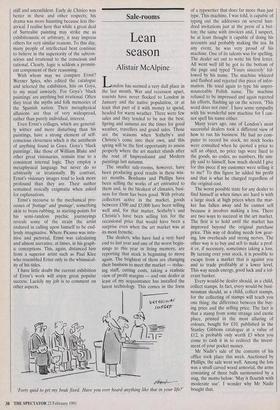Sale-rooms
Lean season
Alistair McAlpine
London has seemed a very dull place in the last month. War and recession apart, tourists have never flocked to London in January and the native population, or at least that part of it with money to spend, headed for warm weather. There were few sales and they tended to be not the best. Spring and autumn are the times for good weather, travellers and grand sales. Those are the seasons when Sotheby's and Christie's come into their own, and this spring will be the first opportunity to assess properly where the art market strands after the rout of Impressionist and Modern paintings last autumn.
The smaller sale-rooms, however, have been producing good results in these win- ter months. Bonhams and Phillips have been selling the works of art entrusted to them and, in the bleakest of climates, busi- ness for them has been good. With private collectors active in the market, goods between £500 and £5,000 have been selling well and, for that matter, Sotheby's and Christie's have been selling lots for the occasional price that would have been a surprise even when the art market was at its most frenetic.
The dealers, who have had a very hard end to last year and one of the worst begin- nings to this year in living memory, are reporting that stock is beginning to move again. The brightest of them are changing their business to meet the market — reduc- ing staff, cutting costs, taking a realistic view of profit margins — and one dealer at least of my acquaintance has installed the latest technology. This comes in the form 'Forty quid to get my beak fixed. Have you ever heard anything like that in your life?' of a typewriter that does far more than just type. This machine, I was told, is capable of typing out the addresses on several hun- dred invitations just at the press of a but- ton; the same with invoices and, I suspect, he at least thought it capable of doing his accounts and probably making the tea. In any event, he was very proud of his machine. One of its talents was for spelling. The dealer set out to write his first letter. All went well till he got to the bottom of the page and typed 'Yours sincerely' fol- lowed by his name. The machine whizzed and flashed and rejected this piece of infor- mation. He tried again to type his unpro- nounceable Polish name. The machine refused to be impressed and again rejected his efforts, flashing up on the screen, 'This word does not exist'. I have some sympathy with his wonderful new machine for I can- not spell his name either.
Many years ago, one of London's most successful dealers took a different view of how to run his business. He had no com- puter to record his stock, no stock books were consulted when he quoted a price to sell an object, no price tags were fixed to the goods, no codes, no numbers. He sim- ply said to himself, how much should I give for this piece if my customer were selling it to me? To this figure he added his profit and that is what he charged regardless of the original cost.
The worst possible state for any dealer to find himself in when times are hard is with a large stock at high prices when the mar- ket has fallen away and he cannot sell because it involves making a loss. There are two ways to succeed in the art market. The first is to hold until the market has improved beyond the original purchase price. This way of dealing needs low gear- ing, low overheads and strong nerves. The other way is to buy and sell to make a prof- it or, if necessary, sometimes taking a loss. By turning over your stock, it is possible to escape from a market that is against you and to trade profitably at a lower level. This way needs energy, good luck and a tol- erant banker.
Every would-be dealer should, as a child, collect stamps. In fact, every would-be busi- nessman should, as a child, collect stamps, for the collecting of stamps will teach you one thing: the difference between the buy- ing price and the selling price. The fact is that a stamp from some strange and exotic place, printed in the most alluring of colours, bought for £10, published in the Stanley Gibbons catalogue at a value of £12, is probably only worth £3 when you come to cash it in to redirect the invest- ment of your pocket money.
Mr Nadir's sale of the contents of his office took place this week. Auctioned by Phillips, the sale went well. Among the lots was a small carved wood armorial, the arms consisting of three balls surmounted by a stag, the motto below: 'May it flourish with moderate use'. I wonder why Mr Nadir bought that.


















































 Previous page
Previous page